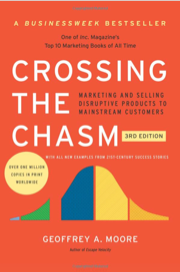Guest article by Bob Apollo of Inflexion-Point Strategy Partners:
When Geoffrey Moore’s “Crossing the Chasm” first appeared 20 years ago it became an instant hit and an inspiration to successive generations of technology marketers. In fact, I can’t think of any single book that has had a more powerful (or, in the early days, disruptive) impact on how I think about taking technology products to market.
Moore explained that the adoption curve for new technologies is marked by a profound disruption in customer behaviour between early adopters and the pragmatic buyers that represent the vast majority (and all of the profits) in most B2B markets.
The path to market leadership
The book offers B2B marketers a mind-set (and a collection of practical principles) that helps them cross this chasm and breakthrough into mainstream markets. I’ve seen the thinking applied to great effect across a range of technology-based B2B-focused businesses – many emerging as market leaders and earning substantial valuations.
But can any book remain relevant in a world that has changed so substantially over the past two decades? I think that question is eloquently answered by the release of the 3rd edition this month. Moore has held firm to the basic principles, but updated them to take account of the modern B2B buying environment.
Mitigating adoption risk
At the end of the day – and this was true when the book was first published, although I’ll acknowledge that I didn’t see it quite as clearly then – Crossing the Chasm is fundamentally about the mitigation of the risks associated with the adoption of new technologies for both the vendor and the customer.
And although many new B2C technologies carry little or no perceived adoption risk – and therefore have very different adoption dynamics (think Google, Facebook, Twitter, etc.), the fact remains that any technology you are going to bet the success of your business on continues to carry significant perceived risks when it is considered unproven by conservative minded buyers.
Adapting to changing dynamics:
B2B tech-based businesses still face that Chasm – and need to cross it if they are to earn the rewards that their technology is capable of generating. It’s just that changes in market dynamics have gone some way to make the Chasm seem less intimidating. Here are three examples:
1. As-a-Service business models
You’ve only got to look at the runaway success of companies like salesforce.com to realise that the software-as-a-service business model serves to reduce both the entry costs and the perceived risks of adopting new technologies.
It used to be true (and is still true to a lesser extent) that the first SaaS solution in the door faced two parallel sales cycles – one to sell the solution, and the other to sell the concept of SaaS to the customer organisation.
But once that first SaaS concept sale has been accomplished, it typically lowers the perceived adoption risk and opens the way for other SaaS solutions to be rapidly embraced by the customer organisation.
2. Eliminating barriers to distribution
I can remember the ability to access value-added channels as being an intimidating barrier to entry for many complex B2B-focused technologies. But we are all now much less reliant on a pure face-to-face selling model (even in complex sales, the majority of customer learning is conducted over the web rather than in physical meetings).
This has had a significant impact of channel dynamics: as I know from our own experience, it’s hard for any third party to make an adequate living solely on the basis of referral or reseller commissions from SaaS based solutions – you’ve got to be able to attach profitable services to the transaction.
3. The rise of the digital native
Our potential customers are now far better informed – and more open to the experiences of others – than they were when the book was first published. Although pure word of mouth references still carry particular weight, web references and rankings have a significant impact on customer decision-making and validation.
This is not just about having a visible brand or positive user reviews: it’s about being perceived as an expert – and a potential trusted adviser – in solving the critical problems being faced by your intended target audience.
Stop digging and start filling in
In complex B2B sales, the chasm in the adoption curve still exists, even if it is shallower or narrower than it might have been in some markets. But it still exists, and it still needs to be navigated. It’s just that there are fewer valid excuses for getting stuck at the bottom of it.
One last thought: today – as 20 years ago – one of the keys to successfully crossing the chasm is accurately targeting a receptive market. This guide may help.
______________________________________________________________________
Thanks to Bob Apollo of Inflexion-Point for this guest blog, which originally appeared on the Inflexion-Point Strategy Partners site in January 2014, click here to view it.
